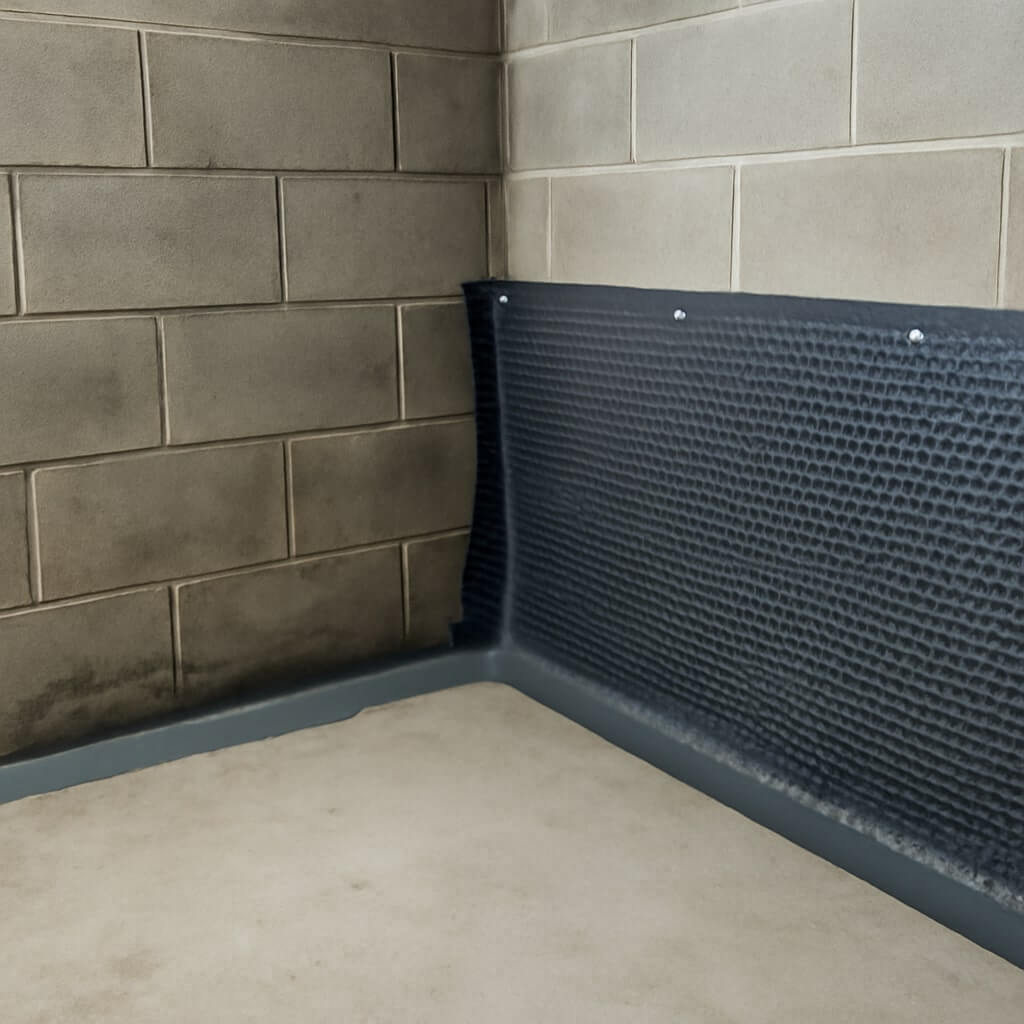When choosing an interior basement waterproofing membrane, you need to assess various factors that can impact performance and longevity. Consider the moisture sources your basement faces, the compatibility with existing structures, and the specific climate conditions in your area. Each membrane type—sheet, liquid, or composite—offers distinct advantages and challenges. Understanding these nuances can lead to more informed decisions, but there are several critical aspects to explore further.
Key Takeaways
- Assess moisture sources like groundwater and plumbing leaks to select the most suitable waterproofing membrane for your basement.
- Choose between sheet, liquid, or composite membranes based on installation methods and compatibility with existing structures.
- Prioritize durability and longevity by selecting materials with high tensile strength and resistance to extreme weather conditions.
- Evaluate installation complexity and maintenance requirements to ensure ease of application and long-term effectiveness.
- Consider cost factors, including material, installation, and environmental impact, to make an informed investment in waterproofing solutions.
Understanding Basement Water Issues
Understanding the factors that contribute to basement water issues is essential for effective waterproofing. You need to identify moisture sources, such as groundwater infiltration, surface runoff, or plumbing leaks. Each source demands a tailored approach to mitigate risks.
Implementing appropriate drainage solutions, like sump pumps or French drains, can greatly reduce water accumulation. Regular inspections and maintenance of gutters and downspouts also help divert water away from your foundation.
Types of Waterproofing Membranes
When selecting a waterproofing membrane, you’ll encounter three main types: sheet, liquid, and composite membranes.
Each type offers distinct advantages tailored to specific basement conditions and installation methods.
Understanding these differences is essential for making an informed choice for effective water management.
Sheet Membranes Overview
Sheet membranes serve as a critical barrier in basement waterproofing, effectively preventing water intrusion from external sources.
You’ll find various sheet membrane types, including polyethylene, rubberized asphalt, and modified bitumen, each offering unique advantages suited to specific conditions.
Proper installation techniques are essential: membranes should be applied to clean, dry surfaces, ensuring full adhesion for peak performance.
Overlapping seams and using compatible adhesives can enhance waterproofing efficiency.
Understanding the characteristics of each membrane type and following precise installation guidelines will maximize your basement’s protection against moisture, safeguarding your investment and maintaining a healthy living environment.
Liquid Membranes Benefits
While sheet membranes provide effective waterproofing solutions, liquid membranes offer distinct advantages that make them a popular choice for basement applications.
Their liquid application techniques allow for seamless coverage, ensuring that hard-to-reach areas are adequately protected. This adaptability enhances moisture barrier effectiveness, as liquid membranes conform to the surface irregularities, forming a continuous barrier.
Additionally, they cure quickly, minimizing downtime during installation. Liquid membranes are also less prone to punctures or tears compared to their sheet counterparts, providing long-lasting protection.
Composite Membranes Features
Composite membranes combine the strengths of various materials to create a robust waterproofing solution tailored for basement applications.
These membranes typically utilize a combination of synthetic and natural composite materials, enhancing durability and flexibility.
You’ll find that their layered construction effectively resists water intrusion while allowing moisture to escape, reducing mold potential.
Installation techniques vary, but often include adhesive bonding or mechanical fastening, ensuring a secure fit against your basement walls.
Material Durability and Longevity
When selecting an interior basement waterproofing membrane, you’ll need to assess material strength to guarantee it can withstand pressure and impacts.
Consider the weather resistance features that protect against moisture and temperature fluctuations.
Finally, understand the lifespan expectations to gauge how often you may need to replace or maintain the membrane.
Material Strength Assessment
Evaluating the material strength of interior basement waterproofing membranes is essential for ensuring long-lasting protection against moisture infiltration.
You should prioritize materials that undergo rigorous material testing to confirm their structural integrity. High tensile strength and resistance to deformation are critical factors that determine how well a membrane can withstand hydrostatic pressure over time.
Look for certifications or results from standardized tests that indicate durability under varying conditions. By focusing on these aspects, you can select a membrane that not only meets your immediate needs but also provides reliable, long-term performance against moisture-related issues in your basement.
Weather Resistance Features
Although moisture resistance is essential, the weather resistance features of interior basement waterproofing membranes play a pivotal role in their overall durability and longevity. A robust moisture barrier and UV resistance are critical attributes to contemplate.
| Feature | Importance | Impact on Durability |
|---|---|---|
| Moisture Barrier | Prevents water ingress | Increases lifespan |
| UV Resistance | Protects from sunlight | Reduces degradation |
| Material Composition | Enhances strength | Guarantees longevity |
| Installation Quality | Proper adherence | Maximizes effectiveness |
Selecting membranes with strong weather resistance guarantees a long-lasting solution for your basement’s health.
Lifespan Expectations
A well-chosen interior basement waterproofing membrane can last anywhere from 10 to 30 years, depending on material quality and environmental conditions.
To gauge lifespan indicators, consider these factors:
- Material Composition: High-quality materials, like thermoplastic polyolefin, usually outperform cheaper options.
- Installation Quality: Proper installation can greatly enhance longevity and effectiveness.
- Regular Maintenance Expectations: Routine inspections and maintenance can extend the membrane’s lifespan, preventing costly repairs.
Ease of Installation
When selecting an interior basement waterproofing membrane, you’ll want to contemplate how easily it can be installed.
Different membranes require various installation techniques, which can affect your user experience considerably. Some products come with pre-applied adhesives or interlocking systems, making them user-friendly and reducing installation time.
Installation techniques vary among membranes, impacting user experience; opt for those with pre-applied adhesives for ease and efficiency.
Others may necessitate specialized tools or skills, complicating the process. Assess the manufacturer’s guidelines and DIY-friendly features to gauge ease of installation.
If you’re not comfortable with complex setups, opt for membranes that simplify the task, ensuring a smoother installation experience while still achieving effective waterproofing results.
Cost Considerations
When evaluating interior basement waterproofing membranes, you must consider material expenses, installation costs, and the long-term investment involved.
Each of these factors plays a vital role in determining the overall financial impact on your project.
Material Expenses
Understanding the costs associated with interior basement waterproofing membranes is essential for making informed decisions. Your material expenses can vary greatly based on several factors, especially if you’re facing budget constraints.
Consider these key aspects:
- Material Sourcing: Identify reliable suppliers to guarantee quality and cost-effectiveness.
- Types of Membranes: Evaluate options like polyethylene or rubberized asphalt, as they differ in price and durability.
- Volume Required: Calculate the total square footage to determine how much material you’ll need, impacting overall costs.
Installation Costs
Installation costs for interior basement waterproofing membranes can greatly impact your overall project budget. You need to take into account both labor costs and material costs when planning. Understanding these expenses allows for more accurate budgeting and decision-making.
| Cost Type | Estimated Cost per Square Foot |
|---|---|
| Labor Costs | $2 – $4 |
| Material Costs | $1 – $3 |
| Total Average | $3 – $7 |
| Additional Fees | $0.50 – $1 |
Long-term Investment
Although you might see initial costs for interior basement waterproofing membranes as a significant expense, it’s important to view them as a long-term investment.
The waterproofing value you gain can lead to substantial investment returns over time. Consider these factors:
- Preventing Damage: Effective membranes reduce the risk of water damage, saving on costly repairs.
- Increasing Property Value: A dry basement enhances your home’s marketability, boosting its resale value.
- Energy Efficiency: Proper waterproofing can improve insulation, lowering energy costs.
Compatibility With Existing Structures
When selecting an interior basement waterproofing membrane, guaranteeing compatibility with existing structures is essential for effective moisture management. You must consider how the membrane interacts with existing materials to maintain the structural integrity of your basement. Using incompatible membranes can lead to adhesion issues or damage, compromising both performance and durability.
| Factor | Importance |
|---|---|
| Material Type | Must complement existing materials |
| Adhesion Properties | Guarantee strong bond for stability |
| Moisture Control | Optimize for moisture management |
Maintenance Requirements
After confirming compatibility with existing structures, it’s important to address the maintenance requirements of your chosen interior basement waterproofing membrane.
Establishing clear maintenance schedules and conducting routine inspections will guarantee long-term effectiveness. Here are three key maintenance tasks to contemplate:
- Inspect seams and joints quarterly for signs of wear or leakage.
- Clean drainage systems biannually to prevent clogs and guarantee proper water flow.
- Check for mold or mildew annually, as moisture issues can compromise the membrane’s integrity.
Performance in Varying Climate Conditions
Understanding how your interior basement waterproofing membrane performs in varying climate conditions is essential for guaranteeing its long-term effectiveness.
You must consider climate adaptability, as membranes that handle temperature fluctuations effectively will reduce the risk of moisture penetration.
Evaluate materials that maintain their integrity in extreme heat and cold, as some may crack or lose effectiveness over time.
Additionally, look for membranes designed with features that accommodate humidity levels, preventing mold and mildew growth.
Environmental Impact and Safety
Considering the environmental impact and safety of your chosen interior basement waterproofing membrane is essential for responsible home improvement.
Evaluating the environmental impact and safety of your interior basement waterproofing membrane is crucial for responsible home improvement.
Prioritize these aspects to guarantee sustainable solutions that promote human health:
- Sustainable Materials: Select membranes made from eco-friendly materials that minimize environmental harm.
- Low VOC Emissions: Opt for products with low volatile organic compounds to protect indoor air quality.
- Recyclability: Choose membranes that can be recycled or repurposed at the end of their lifespan to reduce landfill waste.
Professional vs. DIY Installation Options
When choosing an interior basement waterproofing membrane, it’s important to weigh your installation options carefully.
Opting for professional installation offers several benefits, including expertise in identifying potential issues, guaranteeing proper application, and often providing warranties. Professionals can efficiently handle complexities that may arise, saving you time and potential costs.
Conversely, DIY installation might seem appealing due to lower upfront costs, but it comes with significant challenges. You’ll need to guarantee proper preparation, materials, and techniques to avoid future problems.
Ultimately, evaluating your skills, budget, and the specific requirements of your project will help you make the best choice.
Conclusion
To summarize, selecting the right interior basement waterproofing membrane requires a thorough understanding of moisture sources, material durability, and installation methods. By weighing cost, maintenance needs, and environmental impact, you can make an informed choice that guarantees long-term protection for your space. Whether you opt for professional installation or a DIY approach, prioritizing compatibility with existing structures and climate considerations will optimize your basement’s waterproofing effectiveness and safeguard your home’s integrity.

